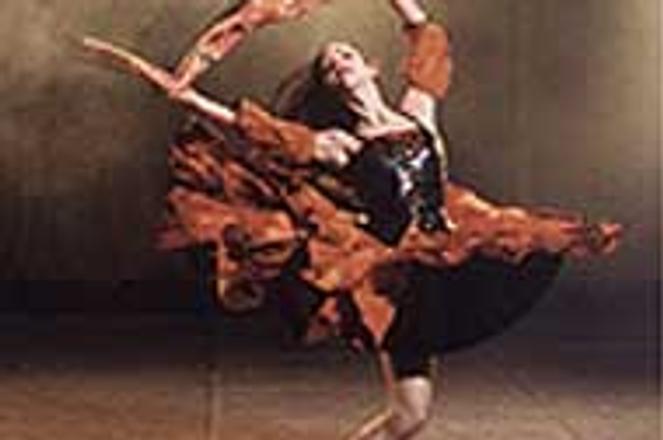Sľuk dancers Miroslav Krajňák and Lucia Mrenková in 'The Magic Fiddle'.photo: Peter Brenkus
Celebrating the beauty and variety of the country's regional communities, traditional Slovak folk-art has long been a source of national pride. Having survived centuries of oppression under Austro-Hungarian and then communist rule, it remains a integral part of the country's ethnic identity.
One group dedicated to the preservation of folk-art is Sľuk, an organisation funded by the Culture Ministry, which has traditionally put on shows featuring distinctly Slovak music and dance. But the original vision of the group has changed in recent years. Rather than simply presenting folk-art in its original form, Sľuk has begun to focus on musical and theatrical productions in an attempt to 'modernise' and thus gain a larger following.
"We are trying to adapt our vision to the world we live in today" said Sluk Director Peter Antalík. "We want to capture young people's attention and interest by giving folklore a more theatrical approach, modernising it and giving it a new face so the younger generation can recognise themselves."
Antalik said that the change was necessary in order to compensate for a lack of state funding. But Tibor Andrašovan, Sľuk's founding father and a former composer/conductor with the Slovak National Ballet and Opera, disagreed, saying that the new orientation of the group was dangerous deviation from its roots.
"They are moving into another genre," Andrašovan said. "They are moving towards pantomime and theatre which requires acting-talent. Sluk is not ready for this change."
Humble beginnings
Slovak folklore evolved while the country was isolated from the outside world by the Tatra and Small Carpathian mountain ranges during Hungarian rule. Decked out in traditional garb, country folk created their own distinct songs, dance and music, many of which varied from village to village. While 19th century Slovak linguists later tried to unify the nation's customs and dialects into one, traditionalists insisted that the differences should be preserved.
Sľuk has celebrated this rich variety since its establishment in 1949. The group has presented Slovak traditions the world around, including visits to the United States, Asia, Arabic countries, Australia and Europe. But now, only a year after its 50th anniversary, change is at hand.
Recent Sľuk performances, which include The Magic Fiddle (telling the story of the Gypsy beauty Panna and her magic violin) and Strom (The Tree), differ greatly from the performances which first made Sľuk famous. The shows reveal a shift towards the performing arts and away from straight-forward presentations of folk traditions in their pure form.
Sľuk's Antalik said that this 'modernisation' would ensure the continued celebration of Slovak folk-art by appealing to a wider spectrum of viewers. In support of his assertion, he pointed to the commercial success of Riverdance, an Irish production celebrating national traditions.
"Today, Sľuk has to be a business, we can't afford to be artistically conservative." he said. "Folklore can be modernised, but unlike Riverdance, we don't have sufficient finances or the necessary business contacts which would enable such a production."
The fall of communism in 1989 resulted in sudden decline in state support for culture, which in turn forced the organisation to cut over half its staff from its heyday in the 1970's. Unless changes in the company's funding structure are made, the future of Sľuk is uncertain, Antalik said.
"In the 70s, 4% of our income came from ticket sales while the remaining 96% was provided by the state," he said. "Now we have to earn 30 to 40% ourselves in order to pay for rent, transport and salaries. We've had to cut back to 102 people, which we've been criticised for, but it's a question of finances. The quality of what we create, sadly, depends not on our abilities but on our finances."
But Branislav Rezník, the Culture Ministry's Art Section Director, said that Sľuk should consider itself lucky. During the current era of economic hardship and subsequent financing cutbacks, he said the organisation was receiving far more than most of its cultural counterparts.
"Sľuk received 20.5 million Slovak crowns from the Ministry this year, a mere 3% decrease from last year," Rezník said. "Furthermore, they will receive 210,000 crowns to finance trips abroad to Spain, Germany and the Czech Republic. I understand their difficulties, but in Slovakia's present financial situation, we can only give limited grants."
Andrašovan also refuted Sľuk's claim of insufficient funding. As he sees it, the problem lies in the changed direction of the organisation and in the fact that they now face competition from other countries hoping to spread their cultural roots as well.
"The problem is not a lack of money, it's a problem of a lack of originality," he said. "Foreigners want something unique and now there is greater competition with countries like Russia, Bulgaria and Poland since the fall of communism. Sľuk has simply abandoned its original mission of drawing on the richness and variety of authentic folklore."


